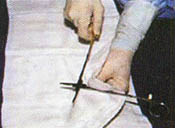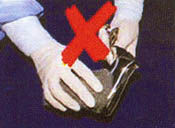| 1. | New instruments should be cleaned, dried and sterilized before the first use. |
| 2. | Most cold sterilization solution render instruments sterile only after a 10 hour immersion. This prolonged chemical action can be more detrimental to surgical instruments than the usual 20 minute autoclave cycle. If the instruments need to be "disinfected" only, cold sterilization is ok, as disinfection will take place in only 10 minute. |
| 3. | Always use the proper sterilization/cleaning technique to render the instruments in the require condition to use. For instruments with Tungsten Carbide inserts (needle holder, scissors, tissue forceps), we do no recommend use of solutions containing Benzyl Ammonium Chloride, which will destroy the Tungsten Carbide inserts. |
| 4. | Following proper cleaning procedures will prevent most instruments from staining. Below is a list of possible stain causes and solutions. It is important to act quickly should a problem arise. Delay will only add to the problem and irreparable harm may result to the instruments. |
| | BLACK STAINS: The result of contact with ammonia. Many cleaning compounds contain ammonia that remains on the instrument unless the are rinsed well. Black stains may also be the result of amine deposits traced to the stream in autoclaves. Cleaning solutions often combines amines. |
| | SOLUTIONS: It is important to follow steam line cleaning procedures with a cycle of distilled water to remove all traces of amines from the autoclave system. |
| | BLUE STAINS: Usually the result of cold sterilization techniques, It is important to prepare the solution according to exact proportions and no change the solution as recommended. Exceeding the manufacturer time limit could result in serious instrument corrosion. |
| | SOLUTION: Use distilled water and a rust inhibitor in the solution to help slow discoloration. |
| | BROWN STAINS: Detergents containing polyphosphates may dissolve copper elements in the sterilizer. this result in copper being deposited on the instruments buy an electrolytic reaction. A dull brown stain is usually a build up of oxidation on the surface. |
| | SOLUTION: Try different detergent or check the quantities being used. The oxidation build-up will not harm the instrument and will protect it from serious corrosion. |
| | LIGHT OR DARK SPOTS: The result of slow evaporation of water condensation the instrument. What remains is mineral deposit, which is related to the mineral content of the water. |
| | SOLUTION: Try using distilled water for sterilizing procedures to help eliminate the formation of these remains residual spots. Also it is very important to follow the autoclave operating instruction provided by the manufacturer. Spot may results in the autoclave doors and opened before the steam is completely vented. another cause of spotting can be traced to instrument wraps. During laundering procedures it is vital that detergents are thoroughly rinses out and that the final rinse is prepare. |
| | RUST DEPOSITS: Surgical grade stainless steel usually does not rust. what appear to be rust is usually residual organic matter in box locks or mineral deposits which have backed on to the surface of the instrument. in localities where the water has a high iron content, an an iron deposit will result in a metallic film on the instrument. |
| | SOLUTION: This is not the fault of the instruments and can be prevented with the use of distilled and dematerialized water during the cleaning procedures. |
| 5. | All instrument should be clean thoroughly immediately after use. |
| 6. | Instruments with joints have to opened before cleaning and disinfection. |
| 7. | Don't use wire brushes or abrasive cleaner. |
| 8. | Delicate Instruments and mouth mirrors should be cleaned by hands. Do not use ultrasonic cleaning machines. |
| 9. | When using ultrasonic machines the instruments should be firmly fixed in the tray. |
| 10. | carbon steel and nickel or chrome plated instruments, should not be cleaned or sterilized together with stainless steel instruments, as this could cause corrosion. |
| 11. | When using ultrasonic cleaners follow maker's instructions carefully. To strong solutions or immersion for long period can cause corrosion. |
| 12. | after cleaning, wash instruments in clean water preferably distilled or demineralized water. Dry the instruments thoroughly and check cleanness and functions. |
| 13. | Dry instruments before sterilizing in hot air or autoclave. |
| 14. | When using chemicals the manufacturer's instructions must be followed. |
| 15. | Regular lubrication is essential to maintain instrument quality and performance. |
| | |
| | We would like to thank all the friends of our products for the trust they have placed in us which will continue to justify in the future. |


